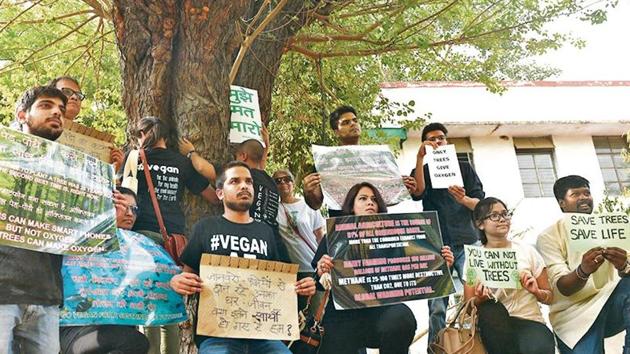Plan to translocate trees paves way for 3 housing projects in South Delhi
The petition has also contends that the cumulative impact of redevelopment of colonies has not been assessed in the environmental impact assessment process, despite being a “single” urban development project.
Three of seven government housing projects in south Delhi that were embroiled in a controversy since 2018 because the original proposal called for the felling more than 16,000 trees, have been recommended for clearance by the Union government’s expert appraisal committee (EAC) in last two months, according to minutes of meetings accessed by HT.

EAC was considering revised plans for the projects in Netaji Nagar, Sarojini Nagar and Kasturba Nagar colonies. It cleared the first two of the projects on March 28, and the third on April 23. The project in Sriniwaspuri had already been recommended for clearance by the committee in January.
According to these plans, fewer trees are to be felled, and a large number are to be translocated. A March 19, 2019, HT report showed that a panel comprising officials of forest department and Central Public Works Department (CPWD) had, in 2017, found that of the 1,713 trees supposed to be transplanted from Pragati Maidan, less than 3% would survive the process.
Following large-scale protests by citizens groups over the proposal fort the seven General Pool Residential Accommodation (GPRA) projects last year, Union housing and urban affairs minister, Hardeep Singh Puri, had assured that the plans — in which low-rise housing is being replaced by high-rise apartments — would be revised to minimise the felling of trees.
HT had first reported on the proposal and its impact on the environment in June 17, 2018.
The EAC clearances are conditional to the outcome in the Dr KK Mishra vs Union of India case being heard by the Delhi high court. The main contentions of the petition is that the GPRA projects have not taken into account the massive impact on tree cover, air quality, and traffic congestion.
The petition has also contends that the cumulative impact of redevelopment of colonies has not been assessed in the environmental impact assessment process, despite being a “single” urban development project.
The revised Sriniwaspuri GPRA colony proposal shows that a large number of trees will be translocated, instead of being felled. In Sriniwaspuri, 1,336 trees were to be felled as per the previous plan, but now, 1,239 are proposed to be translocated.
Of 11,913 trees to be felled in Sarojini Nagar, 3,500 trees will be translocated and the rest retained, according to the revised plan. In Netaji Nagar, of the 3,906 proposed trees to be felled, 1,600 are to be translocated and the rest retained. In Kasturba Nagar, 405 will be translocated, and 798 retained, as per the EAC meeting minutes.
An affidavit filed in January 2019 by the Union government in the Dr KK Mishra case states that “the redevelopment of seven GPRA colonies is conceptualised based on comprehensive planning and vision considering it a single urban project. Commercial components of all seven colonies have been consolidated and proposed to be developed at Naoroji Nagar and partly at Sarojini Nagar.”
Gautam Bhan, the amicus curiae in this case, in his written submission to the high court, said in August 2018: “My principal recommendation is that the project of this scale must be treated as an integrated project rather than several individual ones.”
According to an environment ministry memorandum of 2010, all interlinked and integrated project should have a common environment impact assessment.
SD Meena, chairman cum managing director of NBCC, which along with Central Public Works Department is redeveloping the colonies, did not comment on the need for a cumulative assessment. “These approvals have deliberately disregarded the very legal requirement based on which this integrated project should have been assessed. The cumulative impacts have not been disclosed for the second time despite it being raised in the court, before the ministry, in the media and in citizen’s protests,” said Kanchi Kohli, a legal researcher at Centre for Policy Research (CPR).
“The projects are one, to maximise commercial infrastructure as per the Delhi Master Plan, but singled out when it comes to revealing social and environmental impacts,” she added.
Stay updated with all top Cities including, Bengaluru, Delhi, Mumbai and more across India. Stay informed on the latest happenings in World News along with Delhi Election 2025 and Delhi Election Result 2025 Live, New Delhi Election Result Live, Kalkaji Election Result Live at Hindustan Times.
Stay updated with all top Cities including, Bengaluru, Delhi, Mumbai and more across India. Stay informed on the latest happenings in World News along with Delhi Election 2025 and Delhi Election Result 2025 Live, New Delhi Election Result Live, Kalkaji Election Result Live at Hindustan Times.






